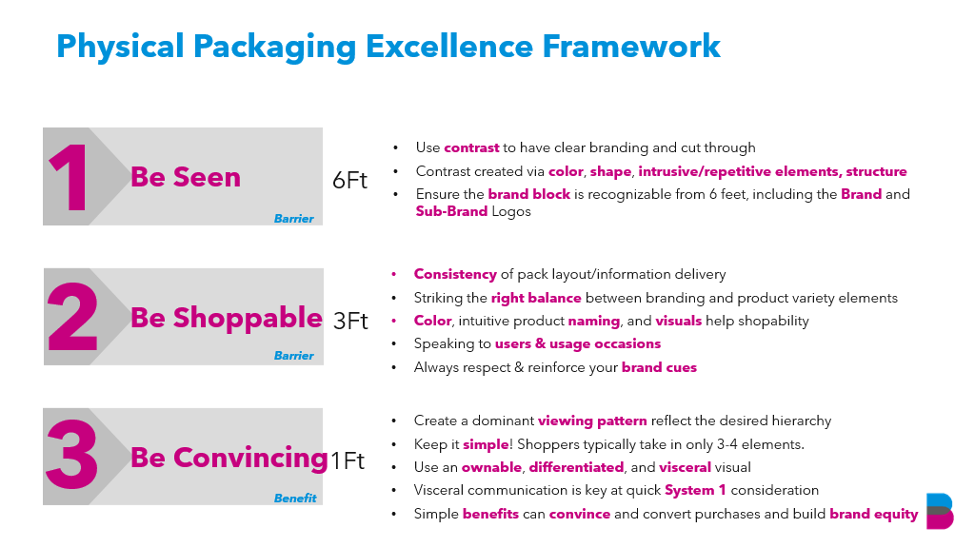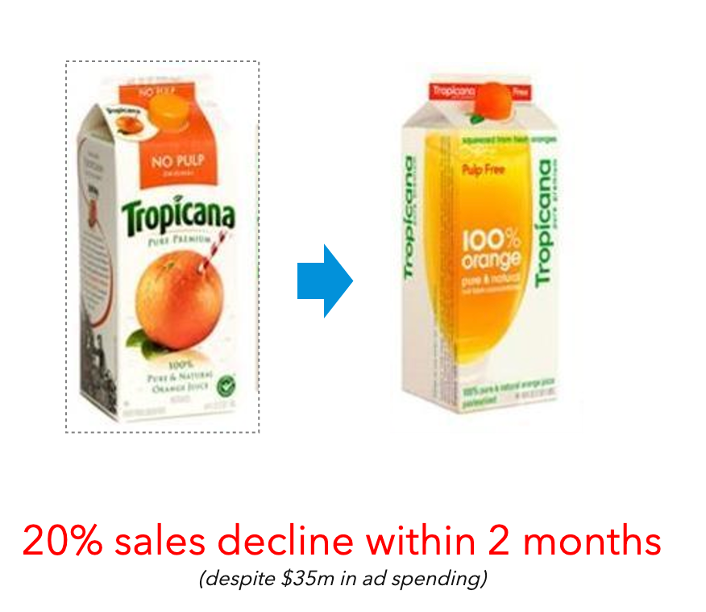SPONSORED CONTENT
What makes a winner? In the quest to win on the physical and digital shelf, your one and only goal is to influence consumers to buy your product. A big part of how they perceive and consider your product comes from your packaging, its relationship to other POSM and its position on the shelf relative to the category, the competition and all the other things competing for the shopper’s attention.
We have spent the better part of 50 years helping clients crack this nut of influencing consumer choice through the optimization of what shoppers see: your pack.
Pack design is an art for sure. But effective packaging extends beyond making something pretty. Good pack design may tap into trends, but it also must evoke a positive emotion and fit an aesthetic that suits your brand. More than that, artful packaging is only winning packaging if it scores the singular measure that counts: Does it influence consumer choice to your advantage?
And the science? For us, it is behavioral science. We have spent our entire almost five decades existence applying the principles of BeSci to evaluate and measure the effectiveness of packaging as a component of driving shopper growth. And you CAN measure potential pack performance with clear unambiguous KPIs, revealing a formula for optimization based on data.
The underlying principle that must guide all decisions in pack design is that packaging ultimately is the servant of shopper growth. As retail (especially grocery) becomes decidedly digital, and concerns about sustainability drive even tougher decisions for manufacturers, the issue of creating winning packaging becomes that much more complex. Ultimately, what goes in the physical and digital cart is the only metric that counts for success or failure of the pack.
Clients come to us so often with questions about general “rules of thumb” for achieving “good” packaging. Over the years, we have published white papers and articles on discrete topics within that objective. This article reflects a distillation of these decades of learning into our unique POV on the art and science of what makes a winner in packaging. Our experience also speaks to global expertise because considerations like the semiotics of color or communications through imagery are not monolithic. Cultural norms play a big part in how packaging will be perceived in different regions.
How you win at shelf with great packaging needs to attack the challenge from multiple angles and degrees of granularity. When we will look at all the questions clients pose to us, we base our recommendations on our unique behavioral framework, defining and diagnosing those aspects of packaging that influence consumer choice. By establishing benefits that make selection easy and eliminating barriers that introduce friction in the shopper path to purchase, we can predict the elements most likely to impact shopper behavior in your favor.
The Basics – Effective Packaging
When we measure pack designs to assess their potential, we start with a framework that considers three basic objectives and the metrics on which effective packaging should therefore be judged: visibility, findability and shopability, (which is really the probability of purchase).
We evaluate these factors in a context that mimics the way shoppers would encounter your product in a physical retail environment: from the aisle (6 feet), at the shelf (3 feet) and once they select and even pick up the product for consideration (1 foot).

These guidelines may differ slightly when addressing images representing pack on the e-commerce shelf but the underlying principles apply: Is the product viewable, findable and will the consumer actually purchase it?
Our proprietary and agile digital solution for rapid and cost-effective pack testing, PackFlash®, provides scores against these KPIs that deliver fundamental and actionable validation of your pack designs, whether they are re-stages, line extensions or new products. And the decades during which we have been collecting, analyzing and weighing data based on changing retail realities give us a database and set of norms that are immensely useful for benchmarking and validating what other agencies can really only present as opinions.
Grounded in Behavioral Thinking
Shopping is an inherently instinctive behavioral activity; unless there is some critical component of a choice that is fatal if you get it wrong (let’s say nuts as an ingredient if a family member has an allergy). Most shopping for grocery is done quickly, intuitively and almost unconsciously. Think about the last time you ever rolled a cart down a brick-and-mortar grocery aisle or replenished your Instacart weekly order. Your mind was probably elsewhere, and your choices were most probably instinctive based on what you saw and recognized. In fact, research has told us that 80% of shopper choices are based on visual shelf impressions.
The pack has to communicate at a visceral level so consumers’ choices can be made according to what behavioral science refers to as System 1 processing.
The application of behavioral science is often overcomplicated in research. We have created a simple yet powerful behavioral framework for determining the potential for packaging to drive choice at shelf:
- Does the pack convey a compelling BENEFIT, making the selection of your product an easy choice?
- Does the pack eliminate BARRIERS that would create friction and introduce reasons not to put your product in the physical or virtual cart?
By measuring benefits and barriers against an unambiguous set of behavioral norms, a pack can be evaluated for its potential to influence a purchase.
And a word about shopability: optimally, the way to validate insights gained through asking about purchase intent is to also observe consumers in the act of actually selecting your product to place in their physical and virtual carts. Thanks to advances in things like online eye-tracking and virtual shelves, online testing can now mimic the what we used to only be able to observe through in-person testing with highly reliable correlation of results. So, we can observe what shoppers are purchasing, rather than solely relying on asking them if they would.
The Nuances
From there, we can address virtually any questions that might be driving a more qualitative and deeper dive around considerations stemming from the unique challenges that clients face. And it is humbling to see how granular and consequential these client questions can get.
They can include:
- “Our major trade partner is shrinking shelf space and mandating products be displayed vertically in our category. What impact will vertical versus horizontal packaging have on effectiveness?”
- “There are colors that fit our category and brand equity. How do we stay true to our brand, reflect category norms and use color to stand out on the shelf? And what impact will color have as we introduce successful products into new global markets?”
- “For sustainability, we would like to eliminate secondary packaging. But when faced with reduced real estate, how can we communicate all the claims and benefits we KNOW make our product the right choice?”
- “We must optimize our packaging for both physical and digital commerce. Is there a way to test for all the elements that impact choice in either setting without making lethal mistakes in either?”
- “As we plan line extensions, we want to grow overall sales volume and avoid cannibalization. How can new packs balance brand recognition, product identification and differentiations (flavor, color or seasonality) without committing the cardinal sin of confusion?”
- “When it comes to sustainability, is my pack delivering the message that the product (and the packaging it comes in), satisfying the consumer’s desire for a choice that is environmentally conscious as well as functionally superior to my competitors?”
The Underlying Guardrails – New Product Packaging
Sometimes what is perhaps the most controversial about our recommendations to clients when they contemplate new packs is why re-design in the first place? What are you likely to lose by walking away from any core brand elements? Are the changes you are introducing truly going to make a difference in terms of viewability, findability and influencing a purchase? Are you taking into consideration the context of both physical and digital retail?
You invest a lot in creating great products knowing that the first time a consumer might see them MAY be on the shelf. Is the pack really going to be the means to influencing choice? Afterall, if we could sell a product, in the old school white box, black type rendition typified by generic packaging decades ago, why wouldn’t we? But we know that consumer behavior and shopper choice is driven by much more complex prompts and triggers that can only be manifested through a well-conceived (and validated) pack design.
Misguided pack changes can lead to double-digit sales declines, while successful packaging can drive growth!
The epic miss Tropicana made in 2009 is an often-told anecdote, but one that remains a cautionary tale for all manufacturers. Somebody thought it was “good design,” but consumers weren’t “buying it!”

We do believe that you can measure and assess what you might lose in a pack redesign, as well as to provide guidelines as to what to fix to limit that risk and identify the elements that can make a winner in whatever you decide to take forward.
Winning Packaging
It would be tempting to dictate a series of absolutes that can guide winning packaging across categories, and geographies in both physical and digital retail environments plus across considerations that promote sustainable shopping and usage once the product is in the home. It may not be comforting for clients when we answer their questions with “It depends…”
But the good news is that our extensive expertise across these questions can provide a customized answer versus pat response to winning at shelf, no matter how unique your specific pack design challenge might be.
About the Author
 Ian Elmer is the managing director, U.S., of Behaviorally (formerly PRS). He leads the client development and qualitative teams, responsible for client service and the growth objectives of the firm’s “diagnose and define” deliverables to drive profitable growth. He has over 20 years of experience influencing global marketing decisions for some of the world’s most iconic brands. Previously, he served as managing director, U.S., at PRS IN VIVO, and held senior client and practice management roles at Kantar and Millward Brown in both the United States and United Kingdom. He brings with him a great breadth of research and consulting knowledge across an array of industries with a proven track record for driving growth in a rapidly changing industry.
Ian Elmer is the managing director, U.S., of Behaviorally (formerly PRS). He leads the client development and qualitative teams, responsible for client service and the growth objectives of the firm’s “diagnose and define” deliverables to drive profitable growth. He has over 20 years of experience influencing global marketing decisions for some of the world’s most iconic brands. Previously, he served as managing director, U.S., at PRS IN VIVO, and held senior client and practice management roles at Kantar and Millward Brown in both the United States and United Kingdom. He brings with him a great breadth of research and consulting knowledge across an array of industries with a proven track record for driving growth in a rapidly changing industry.

